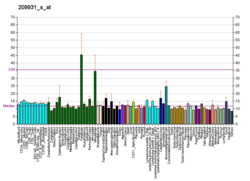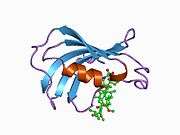FKBP1B
Peptidyl-prolyl cis-trans isomerase FKBP1B is an enzyme that in humans is encoded by the FKBP1B gene.[3][4]
The protein encoded by this gene is a member of the immunophilin protein family, which play a role in immunoregulation and basic cellular processes involving protein folding and trafficking. This encoded protein is a cis-trans prolyl isomerase that binds the immunosuppressants FK506 (tacrolimus) and rapamycin (sirolimus). It is highly similar to the FK506-binding protein 1A. Its physiological role is thought to be in excitation-contraction coupling in cardiac muscle. There are two alternatively spliced transcript variants of this gene encoding different isoforms.[4]
References
- ↑ "Human PubMed Reference:".
- ↑ "Mouse PubMed Reference:".
- ↑ Arakawa H, Nagase H, Hayashi N, Fujiwara T, Ogawa M, Shin S, Nakamura Y (Jun 1994). "Molecular cloning and expression of a novel human gene that is highly homologous to human FK506-binding protein 12kDa (hFKBP-12) and characterization of two alternatively spliced transcripts". Biochem Biophys Res Commun. 200 (2): 836–43. PMID 7513996. doi:10.1006/bbrc.1994.1527.
- 1 2 "Entrez Gene: FKBP1B FK506 binding protein 1B, 12.6 kDa".
Further reading
- Schiene-Fischer C, Yu C (2001). "Receptor accessory folding helper enzymes: the functional role of peptidyl prolyl cis/trans isomerases.". FEBS Lett. 495 (1-2): 1–6. PMID 11322937. doi:10.1016/S0014-5793(01)02326-2.
- Lam E, Martin MM, Timerman AP, et al. (1995). "A novel FK506 binding protein can mediate the immunosuppressive effects of FK506 and is associated with the cardiac ryanodine receptor.". J. Biol. Chem. 270 (44): 26511–22. PMID 7592869. doi:10.1074/jbc.270.44.26511.
- Noguchi N, Takasawa S, Nata K, et al. (1997). "Cyclic ADP-ribose binds to FK506-binding protein 12.6 to release Ca2+ from islet microsomes.". J. Biol. Chem. 272 (6): 3133–6. PMID 9013543. doi:10.1074/jbc.272.6.3133.
- Deivanayagam CC, Carson M, Thotakura A, et al. (2000). "Structure of FKBP12.6 in complex with rapamycin.". Acta Crystallogr. D. 56 (Pt 3): 266–71. PMID 10713512. doi:10.1107/S0907444999016571.
- Marx SO, Reiken S, Hisamatsu Y, et al. (2000). "PKA phosphorylation dissociates FKBP12.6 from the calcium release channel (ryanodine receptor): defective regulation in failing hearts.". Cell. 101 (4): 365–76. PMID 10830164. doi:10.1016/S0092-8674(00)80847-8.
- Jeyakumar LH, Ballester L, Cheng DS, et al. (2001). "FKBP binding characteristics of cardiac microsomes from diverse vertebrates.". Biochem. Biophys. Res. Commun. 281 (4): 979–86. PMID 11237759. doi:10.1006/bbrc.2001.4444.
- George CH, Sorathia R, Bertrand BM, Lai FA (2003). "In situ modulation of the human cardiac ryanodine receptor (hRyR2) by FKBP12.6.". Biochem. J. 370 (Pt 2): 579–89. PMC 1223191
 . PMID 12443530. doi:10.1042/BJ20021433.
. PMID 12443530. doi:10.1042/BJ20021433. - Masumiya H, Wang R, Zhang J, et al. (2003). "Localization of the 12.6-kDa FK506-binding protein (FKBP12.6) binding site to the NH2-terminal domain of the cardiac Ca2+ release channel (ryanodine receptor).". J. Biol. Chem. 278 (6): 3786–92. PMID 12446682. doi:10.1074/jbc.M210962200.
- Tiso N, Salamon M, Bagattin A, et al. (2003). "The binding of the RyR2 calcium channel to its gating protein FKBP12.6 is oppositely affected by ARVD2 and VTSIP mutations.". Biochem. Biophys. Res. Commun. 299 (4): 594–8. PMID 12459180. doi:10.1016/S0006-291X(02)02689-X.
- Strausberg RL, Feingold EA, Grouse LH, et al. (2003). "Generation and initial analysis of more than 15,000 full-length human and mouse cDNA sequences.". Proc. Natl. Acad. Sci. U.S.A. 99 (26): 16899–903. PMC 139241
 . PMID 12477932. doi:10.1073/pnas.242603899.
. PMID 12477932. doi:10.1073/pnas.242603899. - George CH, Higgs GV, Mackrill JJ, Lai FA (2003). "Dysregulated ryanodine receptors mediate cellular toxicity: restoration of normal phenotype by FKBP12.6.". J. Biol. Chem. 278 (31): 28856–64. PMID 12754204. doi:10.1074/jbc.M212440200.
- Nishanian TG, Waldman T (2004). "Interaction of the BMPR-IA tumor suppressor with a developmentally relevant splicing factor.". Biochem. Biophys. Res. Commun. 323 (1): 91–7. PMID 15351706. doi:10.1016/j.bbrc.2004.08.060.
- Gerhard DS, Wagner L, Feingold EA, et al. (2004). "The status, quality, and expansion of the NIH full-length cDNA project: the Mammalian Gene Collection (MGC).". Genome Res. 14 (10B): 2121–7. PMC 528928
 . PMID 15489334. doi:10.1101/gr.2596504.
. PMID 15489334. doi:10.1101/gr.2596504. - Maalej A, Mbarki F, Rebai A, et al. (2005). "Evidence of association between FKBP1B and thyroid autoimmune disorders in a large Tunisian family.". Autoimmunity. 37 (3): 237–9. PMID 15497458. doi:10.1080/08916930410001702478.
- Zissimopoulos S, Lai FA (2005). "Interaction of FKBP12.6 with the cardiac ryanodine receptor C-terminal domain.". J. Biol. Chem. 280 (7): 5475–85. PMID 15591045. doi:10.1074/jbc.M412954200.
- Aizawa Y, Ueda K, Komura S, et al. (2005). "A novel mutation in FKBP12.6 binding region of the human cardiac ryanodine receptor gene (R2401H) in a Japanese patient with catecholaminergic polymorphic ventricular tachycardia.". Int. J. Cardiol. 99 (2): 343–5. PMID 15749201. doi:10.1016/j.ijcard.2003.11.050.
- Wehrens XH, Lehnart SE, Reiken S, et al. (2005). "Enhancing calstabin binding to ryanodine receptors improves cardiac and skeletal muscle function in heart failure.". Proc. Natl. Acad. Sci. U.S.A. 102 (27): 9607–12. PMC 1172237
 . PMID 15972811. doi:10.1073/pnas.0500353102.
. PMID 15972811. doi:10.1073/pnas.0500353102. - Won J, Kim M, Yi YW, et al. (2005). "A magnetic nanoprobe technology for detecting molecular interactions in live cells.". Science. 309 (5731): 121–5. PMID 15994554. doi:10.1126/science.1112869. (Retracted. If this is intentional, please replace
{{Retracted}}with{{Retracted|intentional=yes}}.)
This article is issued from
Wikipedia.
The text is licensed under Creative Commons - Attribution - Sharealike.
Additional terms may apply for the media files.



